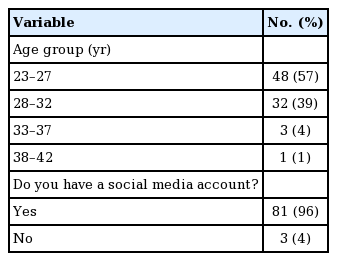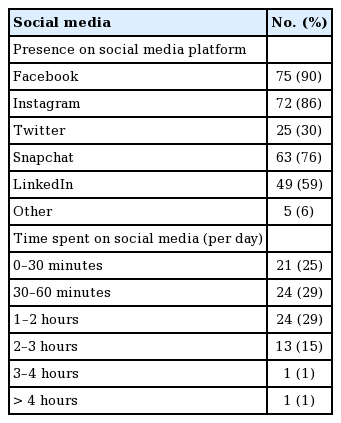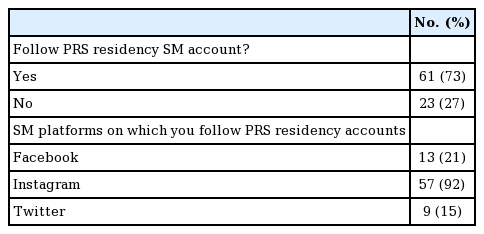Social media impact in the Match: A survey of current trends in the United States
Article information
Abstract
Background
Applicants to integrated plastic and reconstructive surgery (PRS) residency in the United States spend exorbitant amounts of time and money throughout the interview process. Outside of first-hand experience through a visiting rotation, applicants utilize various resources in learning about a program. Today’s applicants are “Millennials,” the demographic cohort raised during the information age and proficient with digital technology. The authors evaluated whether programs have a presence on social media, and whether applicants are following these accounts.
Methods
An online survey was sent to applicants to a single integrated plastic surgery program evaluating basic demographics, social media utilization, and sources of information accessed throughout the residency application process. A manual search of popular social media platforms (Instagram, Facebook, and Twitter) was performed in October 2019. Accounts affiliated with integrated PRS programs were identified and analyzed.
Results
Eighty-four of 222 applicants (37.8%) completed the survey. Ninety-six percent of applicants were within the Millennial demographic. Ninety-six percent of applicants had some form of social media presence, with Facebook (90%) and Instagram (87%) being the most popular platforms. Seventy-three percent of applicants reported following a PRS residency social media account. As of October 2019, 59 integrated residency programs (73%) have active Instagram accounts.
Conclusions
Applicants still rely on the program website when researching potential residencies, but social media is being rapidly adopted by programs. Program social media accounts should be used as a dynamic form of communication to better inform applicants of program strengths and weaknesses.
INTRODUCTION
Since the creation of the modern residency program by Osler and Halsted in the late 19th century, the process of applying to and being accepted into a residency of choice has grown more complex and competitive. Today, integrated plastic and reconstructive surgery (PRS) is one of the most competitive residencies to which medical students apply. Applicants to PRS residencies frequently rank among the highest United States Medical Licensing Examination (USMLE) scores, volume of research experiences, and percent of Alpha Omega Alpha Honor Society (AOA) membership [1].
The recent trend towards adoption of the integrated residency pathway by PRS programs has been coupled with a correlated increase in the Match rate. In the 2019 National Resident Matching Program (NRMP, the Match), there were 78 integrated PRS programs offering 172 positions. In 158 U.S. applicants matched into these positions for a match rate of 92%. In the 2018 Match, this rate was 93% [2].
Despite the increasing match rate, applicants to integrated PRS spend exorbitant amounts of personal time and finances throughout the pre-interview and interview process [3]. Applicants frequently take a “shotgun” approach, applying indiscriminately to every available program. According to recent literature, applicants in the 2017 Match cycle applied to a median 70 out of 73 programs [4]. Anecdotally, most applicants explain this behavior as resulting from a fear of not matching into a competitive field.
However, this behavior is not without consequence. Molina Burbano et al. [4] discussed the “congestion” that exists in the residency interview process as a result of this indiscriminate application approach. The authors reference the game theory phenomenon of “prisoner’s dilemma,” previously described in urology residency application by Weissbart et al. [5], which explains why people tend to act in a self-serving manner, even though cooperation amongst individuals would produce a more beneficial result for all.
In order to develop methods to influence applicant behavior, one must first determine what factors guide their behavior. Specifically, how do applicants learn about a residency program? The best exposure to a program is an intimate, first-hand experience. Outside of the home institution, this experience occurs through Acting Internships (AI), also known as sub-internships or away rotations. These rotations can be costly, both in a financial sense and in opportunity cost, but recent studies have shown that program directors consider an applicant’s performance on the AI as one of the most important factors when formulating a rank list [6].
Due to time and financial limitations, most applicants are only able to attend two to four AIs. Outside of these experiences, multiple studies have shown that a program’s website is an applicant’s primary source of information [7,8]. However, program websites are notoriously lacking regarding the information that applicants desire. In 2015, Hashmi et al. [8] reviewed 67 program websites in search of 31 criteria that were important to applicants. They found that only 25% of program websites had two-thirds of the listed criteria available.
With the rapid evolution of the social media “revolution,” all aspects of society are adopting more modern forms of communication, including Instagram, Facebook, and Twitter. Plastic surgeons in particular are at the forefront of utilizing social media, and the influence of social media on the field of PRS has been heavily studied [9-14]. A large portion of Instagram’s user base are younger Americans. As of June 2019, 59% of U.S. Millennials (the generation born between 1981 and 1996) are active on Instagram, and users under 35 years of age make up 70% of all accounts [15].
Similarly, the demographics of the medical school graduating classes are evolving. Current medical school graduates are now firmly within this “Millennial” generation. Do members of this new generation continue to rely only on websites for sources of information, or is social media a current or potential avenue of communication for programs and applicants to connect?
The aim of this study is to answer two questions: First, in the changing demographics of the PRS residency applicant, what are an applicant’s primary sources of information when learning about a program? Second, are programs recognizing an increased demand for modern forms of mass media by increasing their presence on social media platforms?
METHODS
Survey
First, a list of fourth-year medical students who applied to a Wake Forest Department of Plastic and Reconstructive Surgery via the Electronic Residency Application Service (ERAS) during the 2018 application cycle was generated. A web-based survey (SurveyMonkey Inc., San Mateo, CA, USA) was created to quantify applicant demographics, social media presence, social media utilization, and what sources of information were accessed by the applicant when researching a PRS residency. The survey consisted of 10 questions and was sent via email (Supplemental Material 1) Completion of the survey was incentivized by rewarding a random participant with a $25 Amazon gift card.
Social media data
A list of integrated PRS residency programs participating in the 2018 Match cycle was generated through a downloaded list via the ERAS website. Subsequently, a manual search was performed on three major social media platforms: Instagram, Twitter, and Facebook. A search was conducted using various combinations of the following keywords: plastic surgeon, plastic surgery; reconstructive surgery; residency; plastic surgery residents; resident life; microsurgery; breast reconstruction; and cosmetic surgery. PRS residency program accounts were identified and analyzed. Factors of interest included the date of first post, total number of followers, and total number of posts. All data recorded in this study occurred on a single day–October 9, 2019.
Basic statistical analysis was performed via Microsoft Excel (Microsoft Corp., Redmond, WA, USA) to quantify the results of residency program social media data. Analysis included mean, median, range and percentile. Pearson correlation coefficient (r2) was calculated in Microsoft Excel to determine correlation between various factors of social media accounts (account age, number of posts, number of followers).
RESULTS
The total number of applicants to our institution for the 2018 cycle was 222. Eighty-four survey recipients completed the survey for a completion rate of 37.8%. Eighty-one respondents (96%) are between 23 to 32 years of age. These are firmly members of the “Millennial” generation born between 1986 and 1995. Unsurprisingly, 81 respondents (96%) endorsed having at least one social media account (Table 1).
The two most popular platforms amongst applicants are Facebook (90%) and Instagram (87%). Regarding social media usage, 39 of 84 respondents (46%) spent one hour or more per day on social media platforms (Table 2). Sixty-one respondents (73%) reported following a PRS residency social media account. Of those respondents that do follow a PRS residency social media account, 92% followed the programs on Instagram, compared to only 21% for Facebook and 15% for Twitter (Table 3).
Applicants were asked what sources of information are utilized when progressing through the residency application process, including sources used when applying for AIs and sources used when formally applying for residency interviews through ERAS (Fig. 1). When asked specifically about preparing for the sub-internship/away rotation process, 77 respondents (92%) said that they accessed the website for information, while 71 (86%) accessed the website in preparation for ERAS.

Applicant survey responses sources of program information
Survey results quantifying where applicants access information when researching programs during away rotations (VSAS) versus interview applications (ERAS). VSAS, Visiting Student Application Service; ERAS, Electronic Residency Application Service.
Regarding interpersonal resources (mentor/faculty members, residents, other students) 64 respondents (77%) discussed program selection with a mentor or faculty member at their home institution in preparation for applying as an AI, and 62 (75%) when applying for ERAS. Sixty-eight percent discussed AIs with other residents, either at their home institution or at other institutions, and 66% did the same during ERAS preparation. Fifty-two percent and 51% of respondents discussed AIs and ERAS (respectively) with other applicants. Only 12 respondents (14%) said they accessed a program’s social media account for information during the sub-internship process, and 14 (17%) during ERAS.
Respondents were then asked how likely they would be to access various sources of information during the residency interview process, given that all choices were available to them (Fig. 2). Nearly all respondents (98%) were very likely or somewhat likely to access the program website. This was true also for a mentor/faculty at home institution (99%), other residents (95%), and other applicants (85%). 67% would be very likely or somewhat likely to access a program’s social media account, and 65% would be very likely or somewhat likely to access an online forum/discussion board. Applicants were least likely to utilize direct contact with program coordinator, with 42% choosing “not likely” or “would not access” this source of information.
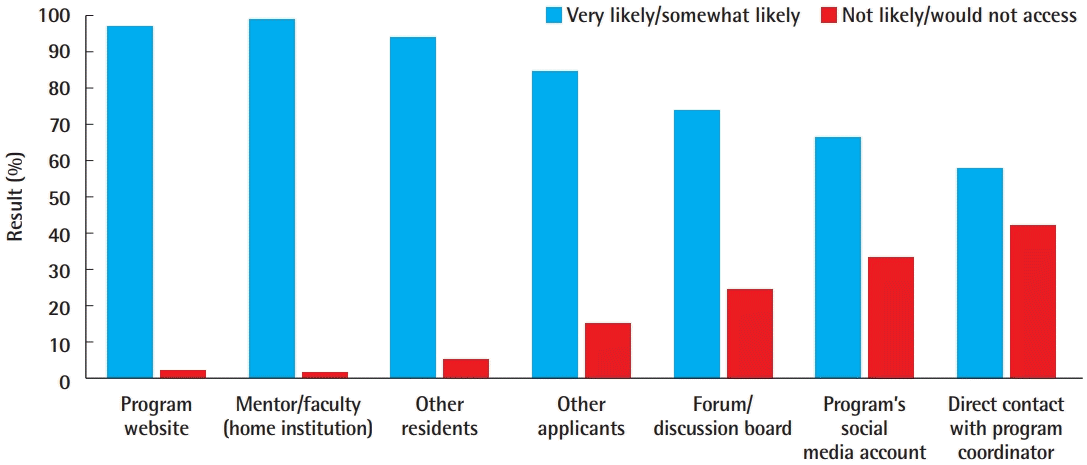
Likelihood of applicants accessing information sources
Self-reported results of whether an applicant would be likely to access a given source of information.
Lastly, applicants were asked what information they desired from PRS residency programs’ social media accounts. Eighty-nine percent and 98% of respondents selected educational content and resident life, respectively. Ten percent selected promotional content. Of the eight free-text responses that selected “Other,” the vast majority mentioned research-related content (current areas of research, awards, etc).
The second aspect of this study focused on the social media accounts of PRS residency programs. Fifty-nine integrated programs (73%) have active Instagram accounts, compared to 23 Twitter accounts (28%) and 16 Facebook accounts (20%). Of the 81 integrated programs, 19 (23%) had no form of social media account through either Facebook, Instagram, or Twitter. Eleven PRS accounts were identified on Instagram that were not associated with an integrated residency program. These were classified as either independent PRS programs, fellowships, or non-U.S. PRS residency programs, and were excluded from analysis.
The earliest identified PRS social media account was on Twitter in October 2009. The earliest Facebook account was December 2010, and the earliest Instagram account was October 2015. Despite Instagram’s shorter lifespan, 58 out of 80 programs currently have an active social media account. This is significantly higher than the number of active Facebook (23) and Twitter (16) accounts. The rate of adoption of Instagram by PRS residency programs has increased exponentially, from five active accounts at the end of 2016 to currently 58 unique programs having an active account as of October 9th, 2019 (Fig. 3).
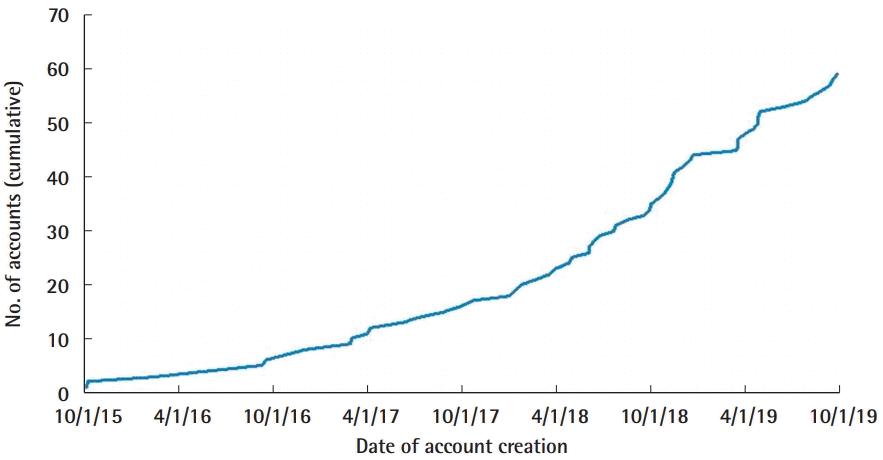
Plastic surgery residency program social media accounts
Number of active plastic and reconstructive surgery residency Instagram accounts, cumulative.
Analysis was performed regarding the age of a PRS residency account, the number of followers, and the number of posts by an account. Regarding Instagram, the number of followers most strongly correlated with the number of posts made by an account (r2=0.58) (Fig. 4A). The age of the Instagram account correlated modestly with number of posts (r2=0.42) (Fig. 4B), and the age of account compared to the number of followers demonstrated the least correlation (r2=0.34) (Fig. 4C).
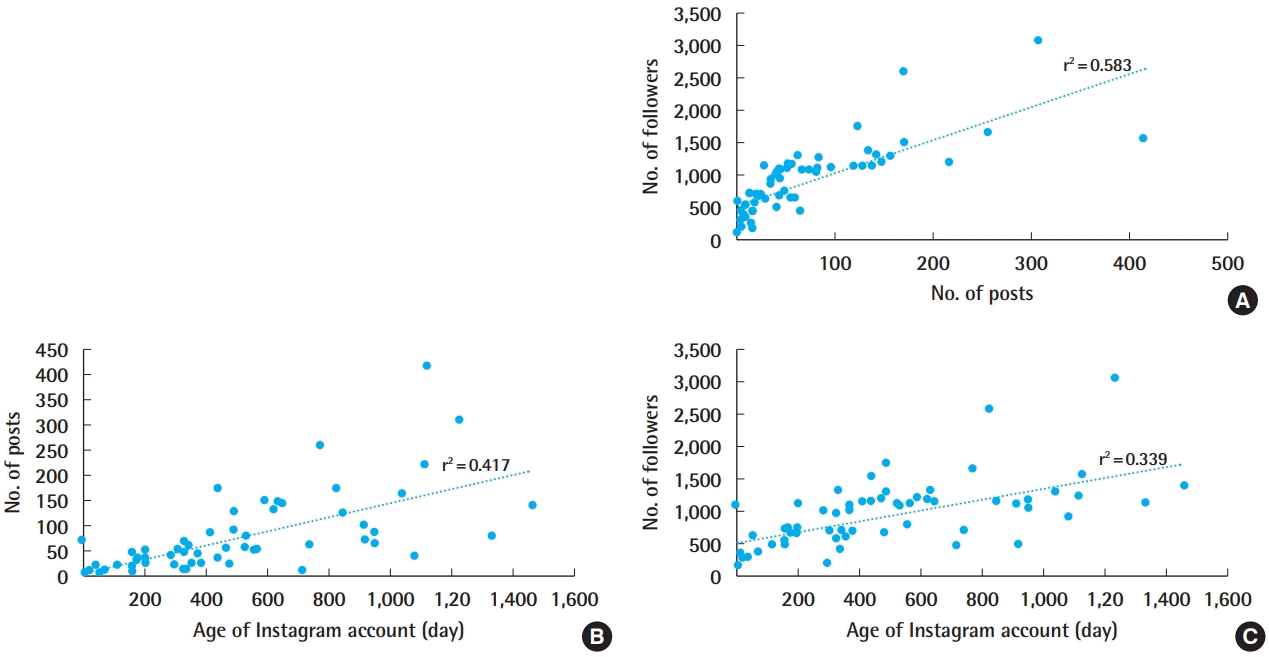
Analysis of PRS residency social media accounts
A graphic depiction of comparison between different variables of social media accounts for plastic and reconstructive surgery (PRS) accounts. (A) Number of posts compared to number of followers; (B) number of posts compared to age of account; (C) age of posts compared to number of followers.
Due to inability to obtain the number of posts on a program’s Facebook account, only age of account and number of followers was obtained, which showed a strong correlation (r2=0.57). On Twitter, there was minimal to no correlation between the number of followers, number of posts, and age of account, with no coefficient of determination (r2) surpassing 0.29.
DISCUSSION
To the authors’ knowledge, this is the first study that has quantified the utilization of resources by applicants to PRS integrated residency programs. Despite the changing applicant demographics, the PRS program website is still the most utilized source of information. Interestingly, interpersonal sources (mentors/faculty, residents, and other students) are a close second source of information. All three of these interpersonal sources are utilized very frequently and are likely valued very highly, given the responses to this survey. However, an individual’s opinion of a program is something not easily modified by programs.
When examining the social media trends of the applicant pool, 96% are in the Millennial generation and, predictably, 96% also have social media accounts. Presence on Instagram and Facebook were nearly equal- 87% and 90%, respectively. Interestingly, 73% of applicants are already following a PRS residency account, and the vast majority of this interaction (92%) occurs on Instagram, compared to 20% on Facebook and 15% on Twitter.
There is some discrepancy between applicants’ current behavior and their reported future behavior. Nearly three-quarters of applicants follow a PRS residency social media account, but in 2018 less than 20% of respondents accessed a program’s social media account for information during the interview cycle. However, 67% said they would be very likely or somewhat likely to access a program’s social media account to obtain information during the interview cycle.
It is difficult to tease out the cause of this discrepancy. Perhaps applicants simply don’t place much value in a program’s social media account. Perhaps programs are on social media but are not active enough to influence their behavior. Or perhaps the impact is subtle or subconscious. Regardless of the cause, there is an opportunity for programs to connect with applicants, both current and future, through social media platforms. And, at least for now, that interaction is most likely to happen on Instagram. Programs should focus their content on resident life and educational content, and avoid posting promotional marketing. In the author’s opinion, the PRS residency social media account should be used as a recruiting tool for medical students, not as a tool to recruit patients.
This study also demonstrates that a vast majority of programs have adopted Instagram as a social media platform. The first adopters were in October 2015, almost exactly 5 years after the initial launch of the photo-sharing platform. Whether programs have independently recognized the importance of this new form of communication, or whether matriculating residents have tapped into their familiarity with social media to promote their respective programs, the exponentially increasing presence of programs on Instagram is unmistakable (Fig. 3). But how does our field utilize this knowledge to modify harmful applicant behavior, specifically in the Match process?
Optimizing the Match process is not an easy problem to solve. As discussed earlier, a vast majority of current applicants apply indiscriminately, likely due to a fear of “missing out” or not matching into an integrated position. However, this creates congestion in the Match process, which negatively impacts both applicants and programs [4]. Decreased review time of applicants by faculty, institution of “cutoffs” (USMLE, research experiences, AOA status), and overbooking of applicants are all results of this congestion [5]. The indiscriminate application to programs of low interest could preclude an interview opportunity for a more suitable applicant who would be a better mutual fit. If programs are better able to communicate with applicants and broadcast their residency experience and expectations, applicants should theoretically begin selectively applying only to programs that fit their future career goals.
Social media may also be used to reach out to potential applicants who have limited or no exposure to Plastic & Reconstructive Surgery. There are currently 81 accredited integrated PRS residency programs, but there are 141 M.D. programs and 34 D.O. programs in the United States. Less than half of US medical schools have an affiliated integrated plastic surgery residency program. Medical students at schools without a home institution have a difficult time gaining exposure to the field of PRS, and social media could be an avenue to introduce a broader population of medical students to our field [16].
As discussed earlier, applicants are frequently dissatisfied with the content of information they are able to access on these websites [7,8]. This information has already led to changes on a national level. At the 2019 Spring Retreat of the American Council of Academic Plastic Surgeons (ACAPS), a motion was adopted to improve the information found on program websites. Our institution developed a list of criteria that we recommend be easily accessible on all PRS residency websites. These criteria include: program coordinator; program leadership; faculty members; program mission statement; program benefits (parking, on-call meals, room/board stipend, etc); curriculum overview; research expectations; and Information on applying to the program.
This study is not without limitations. First, the response rate of fourth-year medical students is low at 38%. However, the fact that 96% of respondents were within the generation of interest lends credibility that this sample is indicative of the applicant pool at large. This rate is also consistent with physician response rates to online polls [17]. Secondly, in the rapidly changing environment of social media popularity, by the time this data is reviewed, a different platform may become the new standard. For example, TikTok is a short-form video-sharing platform that is one of this year’s most popular apps for teenagers [18]. This study does not claim to predict the future, but rather provides a snapshot of the present social media climate as it relates to PRS integrated residency applicants and programs.
Notes
Conflict of interest
No potential conflict of interest relevant to this article was reported.
Author contribution
Conceptualization: all authors. Data curation: TN Steele, L Galarza-Paez, G Aguilo-Seara. Formal analysis: TN Steele. Methodology: TN Steele, L Galarza-Paez, G Aguilo-Seara. Project administration: TN Steele, LR David. Writing - original draft: TN Steele. Writing - review & editing: TN Steele, LR David.
Supplementary material
Supplemental Material 1. Applicant survey questions. Supplemental data can be found at: https://doi.org/10.5999/aps.2020.00836

